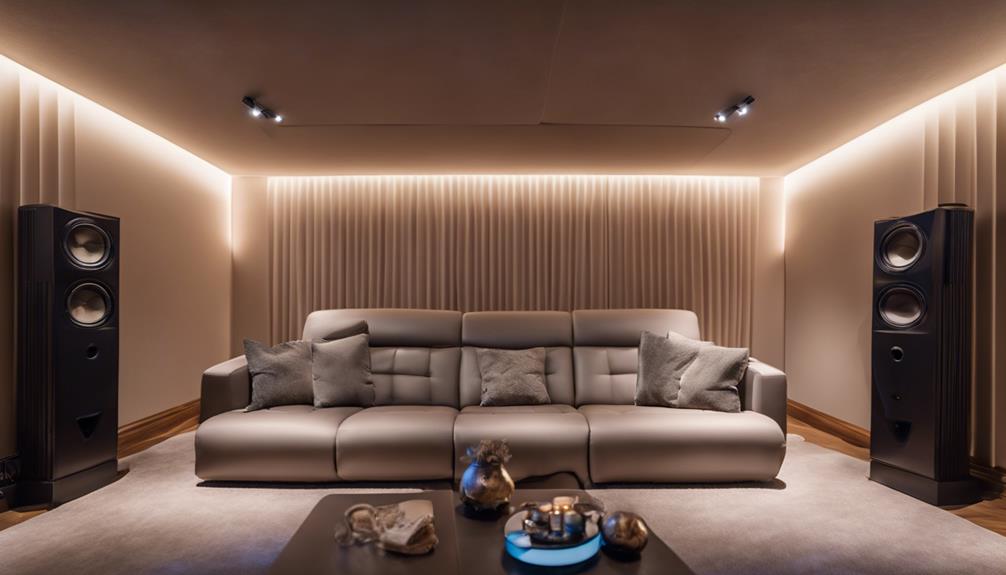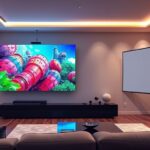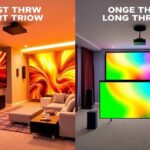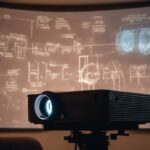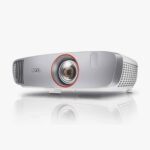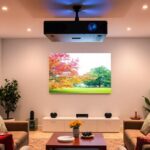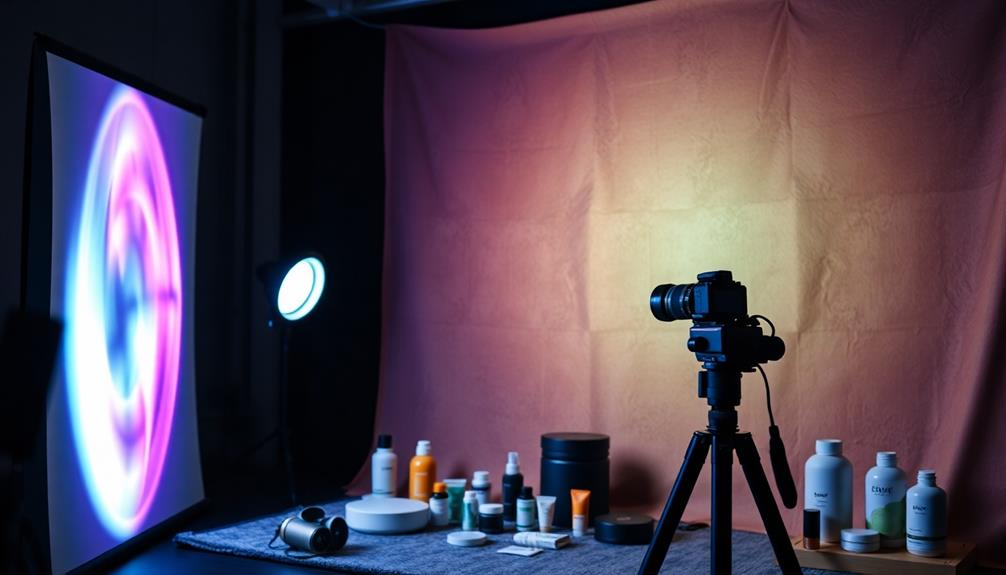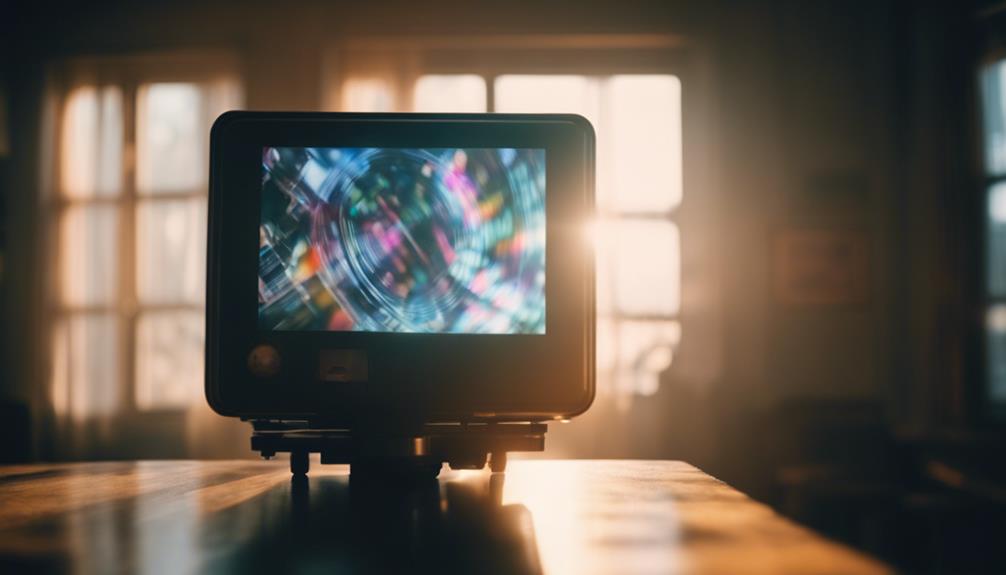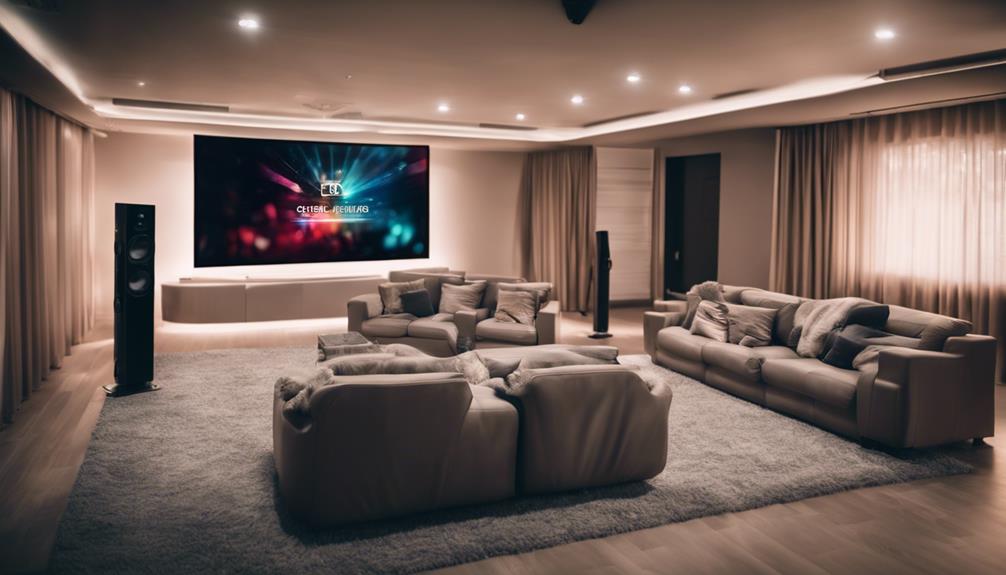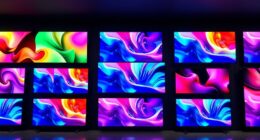When deciding between short throw and long throw projectors, consider your space and needs. Short throw projectors shine in small areas, minimizing shadows and glare while simplifying installation. However, they tend to have a higher price and limited projection range. Long throw projectors excel in larger spaces, offering brighter images and a wider selection. But, they require more distance and can be cumbersome to set up. Each option has its pros and cons that align with different environments. If you're curious about more specific features and recommendations, you'll find additional insights below.
Key Takeaways
- Short throw projectors are ideal for small spaces, requiring only 3 to 8 feet for large image projection, minimizing shadows and glare.
- Long throw projectors can project larger images (up to 200 inches) and are more cost-effective, but require a minimum distance of six feet.
- Short throw projectors often have a higher initial purchase price and limited placement flexibility, while long throw projectors may involve higher maintenance costs.
- Brightness levels and color accuracy are generally superior in long throw projectors, making them suitable for larger venues with ambient light.
Understanding Throw Ratios

Understanding throw ratios is essential for you to choose the right projector for your space and image needs. The throw ratio determines how far your projector needs to be placed to fill the screen.
For instance, short throw projectors typically have a throw ratio between 0.4 and 1.0. This means they can project large images from just a few feet away, making them ideal for small home setups.
On the other hand, long throw projectors require a greater distance, with a throw ratio greater than 1.0. They need to be positioned six feet or more away to create large images, which is suitable for large venues.
When considering projector distance, understanding throw ratios can help you avoid mismatches that lead to suboptimal performance.
For example, a projector with a 2.0:1 throw ratio needs to be placed 12 feet away to fill an 84-inch wide screen. Knowing this information will guide your projector placement and guarantee you select a unit that meets your screen sizes and space requirements.
Ultimately, understanding throw ratios is key to getting the most out of your projector setup.
Short Throw Projector Advantages

Short throw projectors offer a range of advantages, particularly in small spaces where maximizing image size without compromising on distance is essential. You'll appreciate how these projectors can create large images from just 3 to 8 feet away, making them a perfect fit for home theaters or classrooms. Their compact design allows for easy placement, providing flexibility in limited areas.
Here are some key benefits:
- Minimized Shadows and Glare: You'll enjoy a more comfortable viewing experience without distractions.
- Optimal Throw Ratio: With a throw ratio between 0.4 and 1.0, you can easily project large images without needing extensive room depth.
- Advanced Technologies: Many models incorporate features like MEMC, which helps reduce latency and improves image clarity, ensuring a smooth viewing experience.
- Easy Installation: Their compact design allows for simple setup on tables or shelves, making it hassle-free to integrate into your space.
With these advantages, short throw projectors truly maximize your viewing potential while fitting seamlessly into small spaces.
Short Throw Projector Disadvantages

When considering a short throw projector, you should weigh the higher costs and limited projection range against your needs.
You might also encounter potential overheating issues during extended use, which could affect your viewing experience.
It's crucial to evaluate these disadvantages before making your decision.
Higher Cost Considerations
Investing in a short throw projector often means facing a higher initial purchase price, which can strain budgets compared to more affordable long throw options. When you consider the overall investment, it's important to weigh the higher cost considerations carefully.
Here are a few factors to keep in mind:
- Initial Purchase Price: Short throw projectors typically start around $1,000, while you can find basic long throw models for under $500.
- Manufacturing Costs: The advanced technologies and intricate designs of short throw projectors lead to increased manufacturing costs, driving up prices.
- Specialized Light-Rejecting Screens: To optimize image quality, you might need to invest in specialized screens, adding to the overall expense.
- Maintenance Costs: Short throw projectors often require more frequent repairs or replacements, which can further strain your budget.
While short throw projectors offer unique benefits, it's important to evaluate whether their features justify the higher costs compared to long throw projectors, especially if you're working with a tight budget.
Choosing the right option is critical for your financial peace of mind.
Limited Projection Range
While short throw projectors offer unique advantages, their limited projection range can pose challenges for users seeking larger screen sizes and flexible placement options.
Typically, these projectors can only project large images from distances of 3 to 8 feet, which limits their effectiveness for bigger displays. If you're aiming for a screen size over 100 inches, you might find yourself disappointed, as long throw projectors can easily exceed 200 inches.
The proximity required for short throw projection also reduces placement flexibility. You might've to carefully plan your room layout to avoid obstructions and shadows, which can be a hassle. Furthermore, the confined space can lead to overheating issues, impacting performance and longevity.
Additionally, consider the initial cost. Short throw projectors often come with a higher price tag compared to their long throw counterparts. This might limit your options if you're on a budget, especially since the limited projection distance means you won't be able to enjoy the same versatility and screen sizes offered by long throw projectors.
Ultimately, if you prioritize large images and flexible setups, you may want to explore long throw alternatives.
Potential Overheating Issues
How can you enjoy a seamless viewing experience with short throw projectors when potential overheating issues could disrupt your enjoyment? These projectors, while compact and convenient, can run into several overheating problems that may affect your viewing pleasure. Here are some concerns to take into account:
- Heat Buildup: The compact design restricts airflow, leading to excessive heat buildup.
- Performance Drops: Overheating can cause a decrease in performance, affecting brightness levels and image quality.
- Increased Fan Noise: As the projector struggles to cool down, you might notice louder fan noise, interrupting your movie experience.
- Longevity Issues: Continuous overheating can shorten the lifespan of your projector, forcing you to replace it sooner than expected.
To mitigate these risks, guarantee proper ventilation during use. If you don't, you might face automatic shutdowns, diminished image quality, and an overall frustrating experience. While short throw projectors offer unique advantages, it's crucial to be aware of these potential overheating issues to make the most of your investment.
Long Throw Projector Advantages

Long throw projectors excel in delivering large, vibrant images, making them perfect for spacious venues like auditoriums and large conference rooms. These projectors can project images up to 200 inches, ensuring everyone in the audience enjoys a clear view.
With superior image quality and brightness levels ranging from 3500 to 6000 lumens, your presentations will stand out, even in well-lit environments.
For budget-conscious users, long throw projectors are often more cost-effective compared to their short throw counterparts, providing excellent value while supporting larger displays.
Their design greatly reduces vulnerability to obstructions and shadows, which is especially beneficial for outdoor events where distance is essential.
Furthermore, long throw projectors generally have a smaller physical footprint and are lighter, making installation and transport easier for larger setups. This means you can set up quickly without the hassle of heavy equipment.
Long Throw Projector Disadvantages

One notable drawback of long throw projectors is their requirement for a minimum distance of six feet, which can limit your placement options in smaller rooms. This restriction can make setup cumbersome, forcing you to find precise distances while potentially needing ceiling mounts or dedicated stands.
Additionally, you might face several challenges:
- Obstructions and Shadows: Any object in the path between the projector and screen can disrupt image quality.
- Glare Issues: Ambient light can cause glare, diminishing brightness and clarity during daytime use.
- Maintenance Costs: Long throw projectors often require bulb replacements after around 5,000 hours of usage, increasing your ownership expenses.
- Image Quality: If you don't maintain the right distance, you may experience a decline in image quality, which can be frustrating.
These factors can greatly affect your viewing experience, especially if you're working with limited space. So, while long throw projectors deliver impressive visuals, they come with challenges that can complicate your setup and enjoyment.
Key Differences Between Types

When choosing between short throw and long throw projectors, you'll notice key differences in throw distance, image quality, and installation needs.
Short throw projectors shine in tight spaces, while long throw models excel in larger venues.
Understanding these distinctions can help you make the best choice for your setup.
Throw Distance Comparison
Understanding the throw distance is essential, as short throw projectors need just 3 to 8 feet to create large images, while long throw projectors require at least 8 feet for best performance. This difference can greatly influence your setup, especially when weighing the space you have available.
Here are some key points to reflect on:
- Space Efficiency: Short throw projectors are perfect for small rooms, allowing you to project large images without occupying much space.
- Image Size: Long throw projectors can create even larger images, ideal for large venues, but they need more distance to do so effectively.
- Installation Flexibility: You can easily place short throw projectors on tables or desks, while long throw projectors often require elevated mounting.
- Brightness Levels: Short throw projectors typically range from 2000 to 3000 lumens, making them suitable for smaller setups, whereas long throw projectors can achieve 3500 to 6000 lumens, ensuring visibility in expansive spaces.
Choosing between short and long throw projectors hinges on your installation needs and the space you have, so carefully evaluate your options before making a decision.
Image Quality Assessment
Image quality varies considerably between short throw and long throw projectors, impacting your viewing experience based on the environment and setup. Understanding these differences can help you choose the right projector for your needs.
| Feature | Short Throw Projectors | Long Throw Projectors |
|---|---|---|
| Brightness Levels | 2000 – 3000 lumens | 3500 – 6000 lumens |
| Resolution | Up to 1080p | Up to WUXGA (1920 x 1200) |
| Color Accuracy | Moderate | Superior |
| Image Distortion | Higher risk on uneven surfaces | Lower risk with distance |
| Visual Quality | Can suffer in bright settings | Better clarity in spacious areas |
While short throw projectors excel in compact spaces, their lower brightness levels and resolution may compromise image quality in well-lit rooms. Conversely, long throw projectors shine with better color accuracy and clarity, making them suitable for larger environments. The projection distance plays a significant role—short throws may distort images, while long throws provide sharper visuals, maximizing your viewing experience. Choose wisely based on your specific needs!
Installation and Setup
Choosing between short throw and long throw projectors not only affects image quality but also impacts the installation and setup process, which can vary greatly between the two types.
- Short throw projectors can be placed just a few feet away from the screen, making them perfect for small spaces.
- Long throw projectors require significant distance, often needing ceiling mounts or dedicated projector stands, complicating the setup.
- Flexible placement with short throw projectors means quicker installation, while long throw projectors involve careful calculations of throw ratio and screen size.
- Short throw projectors minimize shadow interference, ensuring clearer visibility during presentations, unlike their long throw counterparts that can face obstruction issues.
If you're looking for a hassle-free installation, short throw projectors are your best bet. Their straightforward setup is ideal for tight areas.
On the other hand, long throw projectors may necessitate more planning and precise measurements, which could lead to frustrations if not properly managed.
Ultimately, your choice will dictate not just image quality but also the ease of your installation and setup experience.
Selecting Based on Room Size

When it comes to selecting a projector, the size of your room greatly influences whether a short throw or long throw model is the better fit.
If you've got a small home theater or classroom, short throw projectors are your best bet. They can project large images from just 3 to 8 feet away, minimizing shadows and glare, which enhances visibility. The throw ratio of short throw projectors typically ranges from 0.4 to 1, making them ideal for compact spaces.
On the other hand, if your room size is larger, long throw projectors may be more suitable. These projectors require a distance of 6 feet or more to deliver images, often achieving screen sizes up to 100 inches without compromising image quality. However, be mindful of potential obstructions and glare that can affect viewing in larger areas.
Consider ambient light as well; short throw projectors generally perform better in brightly lit rooms.
Ultimately, your choice will depend on the room size and the desired projection distance, so weigh these factors carefully for the best results.
Budget Considerations

Budget plays a significant role in deciding between short throw and long throw projectors, especially since short throw models often come with a higher price tag due to their advanced technology. If you're working within a budget, consider the following:
- Initial Investment: Short throw projectors typically cost more upfront, while long throw projectors offer more budget-friendly options with decent performance.
- Installation Costs: Long throw projectors might require additional expenses for ceiling mounts and precise distance calculations, impacting your overall budget.
- Maintenance Costs: Long throw projectors generally need lamp replacements after about 5,000 hours, increasing long-term expenses compared to the longer-lasting light sources of short throw projectors.
- Space Requirements and Intended Use: Short throw projectors are perfect for limited spaces, but if you can accommodate a long throw projector in a larger room, you may find better value.
Ultimately, your choice should align with your space requirements and intended use. Balancing these factors will help guarantee you get the best performance without overspending.
Recommended Projector Models

Exploring the best projector models can help you find the perfect fit for your space and needs, whether you prefer a short throw or long throw option. Here are some recommended models to contemplate:
| Model | Throw Ratio | Screen Size |
|---|---|---|
| XGIMI AURA | 0.233:1 | Up to 120 inches |
| XGIMI HORIZON Pro | 1.2:1 | Up to 150 inches |
| WEMAX Nova | Ultra Short | Ideal for compact spaces |
The XGIMI HORIZON Pro offers a 1.2:1 throw ratio and projects up to 150 inches with stunning 4K UHD resolution, making it ideal for an immersive viewing experience. If you're looking for a short throw projector, the XGIMI AURA is impressive, projecting a 120-inch image from just 11.7 inches away while also featuring built-in smart capabilities.
For those on a budget, contemplate the WEMAX Nova, which excels in delivering high-quality visuals in limited space, perfect for home theaters or gaming setups. Each of these projectors provides a unique experience tailored to different screen sizes and preferences.
Frequently Asked Questions
Which Is Better, a Short or Long Throw Projector?
Choosing between a short or long throw projector depends on your space and needs. If you're tight on room, a short throw's perfect. For larger areas, a long throw might suit you better.
What Is the Benefit of a Short Throw Projector?
Oh sure, who doesn't want to trip over cords while trying to project a masterpiece? A short throw projector lets you create stunning displays in cramped spaces without needing a gymnasium-sized room. It's pure genius!
What Is the Lifespan of a Short Throw Projector?
A short throw projector typically lasts around 20,000 hours, thanks to LED or laser technology. With proper maintenance and care, you can greatly extend its lifespan and enjoy consistent performance over time.
Are Ultra Short Throw Projectors Better Than Regular Projectors?
Ultra short throw projectors offer convenience and reduced shadows, but they come with a higher price and require specialized screens. If you prioritize space and image quality, they might be the better choice for you.
Conclusion
In the epic battle of short throw versus long throw projectors, your room size and budget will be your trusty sidekicks.
Short throw projectors can transform any cramped space into a cinematic wonderland, while long throws are like majestic eagles soaring over vast landscapes.
Choose wisely, and you could elevate your movie nights to legendary status!
Don't let indecision hold you back—your dream projector is waiting to light up your life like a thousand fireworks!
Hello, I’m Art, and I’m excited to be a part of the 1Home Theatre Projector team. As a writer, I’m here to contribute my knowledge and insights to help you achieve the ultimate home cinema experience. I understand that making decisions in the world of home entertainment can be complex, and I’m here to simplify the process for you.

